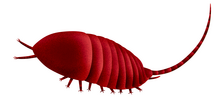| Molaria Temporal range: Cambrian Series 2–Burgess Shale PreꞒ Ꞓ O S D C P T J K Pg N | |
|---|---|

| |
| M. spinifera lectotype | |

| |
| Life restoration of M. spinifera | |
| Scientific classification | |
| Domain: | Eukaryota |
| Kingdom: | Animalia |
| Phylum: | Arthropoda |
| (unranked): | †Artiopoda |
| Genus: | †Molaria Walcott, 1912 |
| Type species | |
| Molaria spinifera Walcott, 1912 | |
| Other species | |
|
Molaria steini Peel, 2017 | |
Molaria is a genus of Cambrian arthropod, the type species M. spinifera is known from the Middle Cambrian Burgess Shale. 144 specimens of Molaria are known from the Greater Phyllopod bed, where they comprise 0.27% of the community. A second species M. steini was described from the Sirius Passet in Greenland in 2017.
Etymology
The genus name derives from “Molar”, the name of a mountain peak east of the Valley of the Ten Peaks in Alberta, Canada, which in turn was so named by James Hector in 1859 because the shape of the mountain resembles a molar tooth. The specific name of the type species, spinifera, comes from Latin spinifer “spine-bearing.”
Description
The body of Molaria consisted of a head shield (cephalon), a trunk consisting of eight sections (tergites), and a telson, which included a short ventral spine and a long posterior spine. Three pairs of legs were beneath the cephalon and another eight pairs were attached to the trunk. Eyes were lacking, but a pair of short antennae was present on the cephalon. Specimens of Molaria ranged from 8 to 26 mm in length from cephalon to telson, with the posterior spine slightly longer than the body length.
Affinity
Molaria was superficially similar to Habelia, another Burgess Shale arthropod with a long tail spine, but which possessed 12 trunk tergites. It is currently considered a member of Artiopoda.
References
- ^ Walcott, C. D. (1912). "Middle Cambrian Branchiopoda, Malacostraca, Trilobita and Merostomata". Smithsonian Miscellaneous Collections. 57: 145–228.
- Caron, Jean-Bernard; Jackson, Donald A. (October 2006). "Taphonomy of the Greater Phyllopod Bed community, Burgess Shale". PALAIOS. 21 (5): 451–65. Bibcode:2006Palai..21..451C. doi:10.2110/palo.2003.P05-070R. JSTOR 20173022. S2CID 53646959.
- ^ Peel, J.S. (2017-06-30). "Molaria (Euarthropoda) from the Sirius Passet Lagerstätte (Cambrian Series 2, Stage 3) of North Greenland". Bulletin of Geosciences: 133–142. doi:10.3140/bull.geosci.1658. ISSN 1802-8225.
- "Molaria spinifera". The Burgess Shale.
- ^ Whittington, H. B. (1981). "Rare Arthropods from the Burgess Shale, Middle Cambrian, British Columbia". Philosophical Transactions of the Royal Society B: Biological Sciences. 292 (1060): 329–357. Bibcode:1981RSPTB.292..329W. doi:10.1098/rstb.1981.0033.
External links
- "Molaria spinifera". Burgess Shale Fossil Gallery. Virtual Museum of Canada. 2011. Archived from the original on 2020-11-12.
| Artiopoda | ||
|---|---|---|
| ||

 | ||
| Taxon identifiers | |
|---|---|
| Molaria | |
This prehistoric arthropod–related article is a stub. You can help Misplaced Pages by expanding it. |



